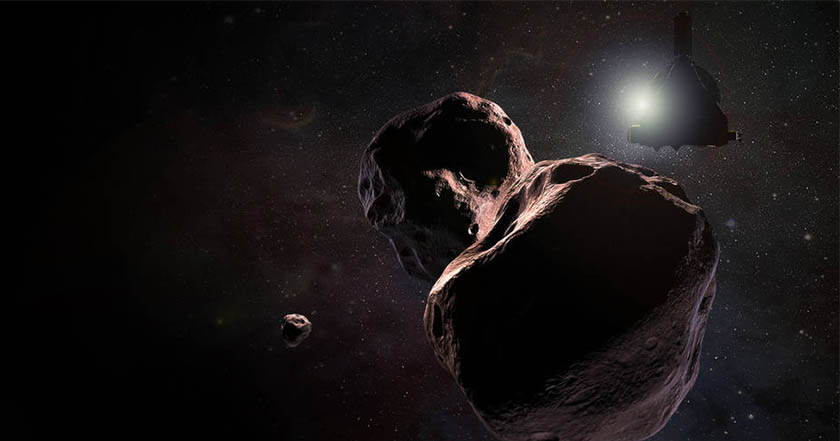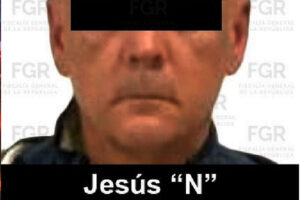Ultima Thule es un objeto rojizo con una forma parecida a la de un muñeco de nieve a 6 mil 600 millones de kilómetros de la Tierra
Regeneración, 3 de enero de 2019. La NASA publicó la primera imagen enviada por la sonda ‘New Horizons‘ de Ultima Thule, un objeto rojizo con una forma parecida a la de un muñeco de nieve a seis mil 600 millones de kilómetros de la Tierra.
Ultima Thule, como ha sido bautizado el diminuto objeto helado, es un cuerpo alargado de unos 32 kilómetros (20 millas) de longitud, compuesto de dos esferas fusionadas.
New Horizons, la sonda que envió fotos de Plutón hace 3 años, pasó junto al misterioso objeto a inicios del Año Nuevo.
Antes de esta misión, el equipo liderado por el científico Alan Stern, del Instituto de Investigación Southwest, sopesó la idea de que Ultima Thule fuese la unión de dos objetos planetarios distintos.
Sin embargo, el científico de la Universidad Johns Hopkins, Hal Weaver, aseguró hoy que se trata de un solo asteroide con una forma similar a un cacahuete o un bolo, después de ver las últimas imágenes de Ultima Thule, aún de muy baja resolución.
«Eso es bastante común entre los cuerpos celestiales pequeños del Sistema Solar», aclaró Weaver en una rueda de prensa convocada tras recibir la primera señal de New Horizons después de completar la misión.
Está a mil 600 millones de kilómetros (1 millón de millas) más allá de Plutón.
El científico Jeff Moore dijo que las dos esferas se formaron cuando pequeños fragmentos se unieron en el espacio miles de millones de años atrás. Entonces las dos esferas se acercaron en espiral y se fusionaron.
Ultima Thule parece tener un color rojizo como el ladrillo. Los científicos dicen que no se ven cráteres de impactos en las nuevas fotos.
Got plans for #NewYears? Watch @NASANewHorizons make history as it reaches #UltimaThule, the farthest object ever explored by a spacecraft. 🛰https://t.co/Jn84tze2HY pic.twitter.com/j4LvhLmNz0
— Johns Hopkins APL (@JHUAPL) 22 de diciembre de 2018
On #NewYearsEve, @NASANewHorizons will perform the most distant planetary flyby ever. Get all the details about this icy rock nicknamed #UltimaThule during today’s 1 p.m. EST briefing with the experts. https://t.co/oJKHgKpQjH pic.twitter.com/NHq5BXGLwh
— NASA (@NASA) 28 de diciembre de 2018
#UltimaThule is an icy rock located ~1 billion miles past Pluto in the Kuiper Belt. On #NewYearsEve, @NASANewHorizons will fly within 2,220 miles of this object, providing the first close-up look at such a pristine building block of the solar system: https://t.co/MT909RJbMM pic.twitter.com/OIqEtkozaH
— NASA (@NASA) 29 de diciembre de 2018
.@NASANewHorizons is making its final approach to #UltimaThule, an icy object located ~1 billion miles past Pluto! Get the latest updates and find out where and when to watch the most distant planetary flyby ever this #NewYearsEve: https://t.co/MT909RJbMM pic.twitter.com/fBsLbt6hd0
— NASA (@NASA) 30 de diciembre de 2018
.@NASANewHorizons experts are gathering @JHUAPL ahead of tonight’s historic flyby of #UltimaThule. Join them live at 8pm ET as they talk about this icy world located ~1 billion miles past Pluto & how it’ll give us insight into the early solar system: https://t.co/oJKHgKpQjH pic.twitter.com/kv1iW9icw1
— NASA (@NASA) 31 de diciembre de 2018
Happy New Year! @NASANewHorizons made its flyby of #UltimaThule at 12:33am ET. We’ll be live at 9:45am ET as we await the confirmation signal from the spacecraft. See you in the morning! pic.twitter.com/g89vbHshdl
— Jim Bridenstine (@JimBridenstine) 1 de enero de 2019
🚨First image of #UltimaThule! 🚨At left is a composite of two images taken by @NASANewHorizons, which provides the best indication of Ultima Thule’s size and shape so far (artist’s impression on right). More photos to come on Jan 2nd! https://t.co/m9ys0VhmLA pic.twitter.com/qZu0KL8uJB
— Johns Hopkins APL (@JHUAPL) 1 de enero de 2019
#UltimaThule used to be 2 separate objects. It likely formed over time as a rotating cloud of small, icy bodies started to combine. Eventually, 2 larger bodies remained & slowly spiraled closer until they touched, forming the bi-lobed object we see today: https://t.co/ZuxLDtzW9c pic.twitter.com/FwWDAaAdey
— NASA (@NASA) 2 de enero de 2019
THIS is #UltimaThule.
The image taken by @NASANewHorizons – shown in its original version (left) & sharpened version (on right) – is the most detailed image of the farthest object ever explored by a spacecraft. https://t.co/gItPsMvbPC @NASA pic.twitter.com/i7rDBURNrw
— Johns Hopkins APL (@JHUAPL) 2 de enero de 2019
After flying by the most distant object ever explored, @NASANewHorizons beamed back the 1st pictures & science data from #UltimaThule. This data is helping us understand how planets form — both those in our own solar system & those orbiting other stars: https://t.co/cp8lE03Cl5 pic.twitter.com/CUaOK1LZBG
— NASA (@NASA) 2 de enero de 2019
On New Year’s Day, @NASANewHorizons flew past #UltimaThule – the most distant object ever explored. While the flyby was quick, it’ll take ~20 months to downlink the full data set from the spacecraft, which is more than ~4 billion miles from the Sun: https://t.co/QrzC8Uy4yf pic.twitter.com/jOvWOluSVH
— NASA (@NASA) 3 de enero de 2019
Zoom with a view: Made from two images taken 38 minutes apart, here is #UltimaThule! The «Thule» lobe is closest to the @NASANewHorizons spacecraft. As Ultima Thule is seen to rotate, hints of the topography can be perceived. @NASAhttps://t.co/fKsyLeW9pY pic.twitter.com/5S9zZ5d3Eg
— Johns Hopkins APL (@JHUAPL) 3 de enero de 2019














